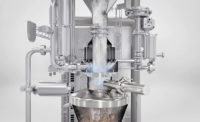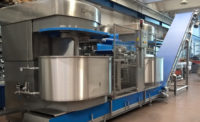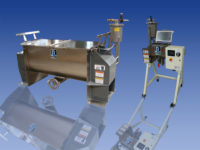Snack food and bakery companies in the market for mixers want machines that provide qualities like ease of sanitation, food safety, automation, airtight seals, and consistent operation that guards against product degradation during the mixing cycle.
Shaffer Mixers, a subsidiary of Bundy Baking Solutions, Urbana, OH, has seen customers asking for machines that provide greater food safety, as well as automation. “Food safety has always been important, but it’s getting more important now,” says Andrew McGhie, director of sales. “Automation is helpful, because skilled people are always tough to get.”
Unifiller Systems, Delta, British Columbia, says its customers have become increasingly concerned about hygienic design and the ability to do wet cleaning, says Lutz Benke, project manager, bakery, DIOSNA mixers. “There have been discussions more and more with customers to take care of hygienic design. More customers have been saying, ‘For our audits and requirements, it’s important that we clean with water.’”
Ken Langhorn, vice president of sales, Charles Ross & Son Company, Hauppauge, NY, says cleanability has come up more frequently in conversations, along with control capabilities. “When people buy equipment, they want the right control panels, something intelligent enough to give them what they want,” he says. “We continue to tailor them to meet customers’ standards.”
Koenig Bakery Systems USA, Ashland, VA, also has noticed rising demand for easier cleaning, to bring about both shorter down times and greater hygiene, says Richard Breeswine, CEO. Dough quality also is a regular concern. “If they do not mix their doughs properly, the dough cannot develop right and will be too sticky,” he says. “We recommend to give the doughs enough mixing time and to test properly.” He notes that snack and bakery companies need to invest time into mixing trials in order to get the best product outcome.
Customers of Munson Machinery Co., Utica, NY, also are focused on quality and safety, says Steve Knauth, marketing manager. “Snack/bakery customers increasingly strive to prevent product degradation through gentle mixing and short time cycles, higher profitability through short mixing and cleaning cycles, and the greatest product safety through visual certification,” he says. They want to ensure that every material contact surface is sanitized to prevent microbial contamination and/or cross-contamination from multiple snack and bakery materials being mixed in the same machine.
Bernhard Noll, CEO, Rapidojet—distributed by Bakery Concepts International, Enola, PA—says snack and bakery customers are focused on issues like hydration, temperature control, and maintenance costs. “One very easy way to do this is to pre-hydrate all the ingredients with high pressure, and have a very short mixing time, so you don’t need ice or active cooling,” he says. “This gives a lot of safety to the whole process.”
SEPCO USA, Alabaster, AL, continues to hear concerns about leakage and contamination around air seals. “One of the primary problems is with product loss, and cleanup, which can lead to OSHA violations,” says Zach Nepa, regional manager. “Product leaking out of the mixer can also cause premature failure of equipment and reduced efficiency within a plant.”
Advanced mixers
Shaffer and Bundy provide mixers that are most often used for bread and buns, although the health food and energy bar category has seen growing usage, McGhie says. The greater interest in automation, which now includes functions like addition of minor ingredients and dough discharge, has required the company to change the design of its mixer from a 140-degree tilt in the horizontal bowl to 180 degrees.
“They’re not having an operator sit in front of a mixer, waiting for it to finish and manually getting the dough out,” says McGhie. “We’re now installing a lot of systems where there’s no operator there at all. It gets the signal from the downstream equipment that we need to start a new batch, because we’re about to run out of this one. It’s helping to save on labor and run more seamlessly.” This approach also doesn’t rely on having floor personnel remember to start a new batch of dough, which can improve throughput and efficiency.
From a sanitation standpoint, Shaffer redesigned its mixers to replace a butterfly valve that stopped back-splash, which was “a sanitation nightmare,” to create an easier-to-clean solution connected with four bolts. “The QA folks love that,” McGhie says. Shaffer’s mixers provide high-pressure clean-in-place (CIP), which is helpful when switching flavors of cookies, for example, or from allergen to non-allergen, he notes.
“Before high-pressure CIP, it would require somebody to physically stand there and dump dough out, and use a high-pressure hose,” says McGhie. That took at least an hour, whereas the high-pressure CIP takes 9 minutes at most. “That’s saving a lot of time on changeover and does a good job of getting it clean.”
In addition, Shaffer has made bowl seals tighter and easier to replace. And the company offers remote input-output controls mounted on the mixer that can be installed much more quickly than in past iterations—in fact, one customer told McGhie it saved as much as $5,000 on the installation.
Rapidojet provides two different sizes of mixers that handle either 1,000 or 5,000 kg per hour, and the machine has been tweaked to handle new applications like mixing of masa flour, and bran hydration for biscuits, Noll says. High-pressure, high-velocity atomized water provides better hydration, he says.
The current iteration of Rapidojet also offers the ability to go to small batches with very short times in between, so the dough doesn’t change its properties too much during the process, Noll says. “You can have small batches in a row, or go to a continuous process,” he says. “We can provide a second mixing chamber, so every few years people can change the chamber, including the nozzle, and it’s done within a minute. They can produce without interruption with one mixing chamber and clean the other one.”
The machine’s high-pressure liquid pump, which requires no metal mixing tool, like a bar, whisk, or paddle, drastically reduces the energy needed to run the Rapidojet, says Ken Schwenger, president, Bakery Concepts International. He notes that this is especially true when working with stiff doughs like masa for tortilla products, mixers normally create a lot of heat and require a cooling agent like glycol. “We instantaneously develop and hydrate the masa for tortillas,” he says. “We don’t need glycol; we don’t need ice.” In addition, he notes, when we use high pressure, it much more efficiently and effectively binds drys and liquids. “Therefore, shelf life is significantly improved.”
Munson’s Rotary Batch Mixer offers rapid blending and cleanup of dry bulk snack and baking ingredients, with or without liquid additions, Knauth says. “It achieves total batch uniformity in one to three minutes, regardless of the disparities in the bulk densities, particular sizes, or flow characteristics of batch ingredients, and discharges with no segregation and no material remaining in the vessel, which eliminates waste and allows rapid sanitizing,” he says.
The mixer has no internal shaft, shaft seals, or agitators, but rather is equipped with proprietary mixing flights that tumble, turn, cut, and fold the material gently as the drum rotates, causing particles to recombine 288 time per minute, Knauth says. “The mixer can be equipped with internal spray lines for liquid coatings, flavorings, and impregnations, achieving batch uniformity to one-tenth of 1 percent, at ratios down to 1 part per million of liquid to solids.”
The mixing flights elevate material and direct it through a discharge gate that pivots into the machine, causing material to flow through a stationary discharge spout, Knauth says. “Large access doors provide unrestricted access for spraying with air, cleaning solutions, or steam; for cross-ventilation of the large open mixing vessel; and for visual inspection of all smooth contact surfaces,” he says.
Munson has introduced various sizes of miniature Rotary Batch Mixers, with capacities as low as 0.25 (7 liters) for off-line laboratory, pilot plant, small-production, or pre-blending applications, results of which are scalable to high-capacity in-line Rotary Batch Mixers that have batch volumes up to 600 cubic feet, Knauth adds.
Koenig provides a spiral mixer, twin twist mixer, and bowl hoist for supplying the lines with mixed dough, all in different capacities, Breeswine says. The twin twist mixers feature two tools with a specially adapted profile placed at a certain angle, designed to increased transfer of mechanical energy and shorten the mixing time. “It obtains excellent results with wheat pastry, cookies, and wafer dough because of air and oxygen, which are working into the dough,” he says, adding that rye and rye-wheat doughs also work well.
The Twin Twist Mixer DW 240 from Koenig has been relaunched with improved hygienic design, now known as the DW 240-H, Breeswine says. It’s entirely washable with low-pressure water, the machine frame and head are completely welded and sealed, construction is stainless steel, and coverings are easily accessible for cleaning and maintenance, he says. The company’s spiral mixer is especially suitable for wheat, wheat and rye, rye, and whole-wheat doughs, he adds.
Unifiller has upgraded the hygienic design of its DIOSNA mixer, used for cereals, rolls, bread doughs, ciabattas, and other bakery products, with an almost completely open structure that’s fully washable, Benke says. “It’s based completely on existing systems, with a new design for cleaning,” he says.
SEPCO USA has reconfigured its seals and branched out from animal cracker applications to those involving powders and chocolates, Nepa says. The technology of the seal has remained the same, but the spatial orientation changes based on the usage. “You can use this seal in a number of different applications,” he says. “The main change is the design, and the ability to adapt to different powders, chocolates, and sugars.”






